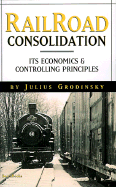|
|
|
|
||||||

|
Railroad Consolidation: Its Economics & Controlling Principles
By Julius Grodinsky 1999/11 - Beard Books 1893122417 - Paperback - Reprint - 351 pp. US$34.95 A classic economic analysis concluding that railroad consolidation is about railroads moving traffic which is a problem of economics and transportation, not politics. Publisher Comments A classic economic analysis of railroad consolidation, written ten years after the passage of the Transportation Act of 1920 that was designed to encourage and promote such consolidation. While other analyses focused on the role of the Interstate Commerce Commission and the effect of politics in encouraging or impeding rail consolidations, the author approached his subject from an economic perspective, asking: What are the business interests that underlie consolidation projects? The answer boils down to a simple fact: railroads exist to move traffic. Thus, the author concludes that railroad consolidations are worked out for the purpose of creating traffic routes favorable to the carriers concerned. His thesis that railroad consolidation was in its essence about traffic - a problem of economics and transportation, not politics - was welcomed as a businesslike perspective on an issue that had become highly politicized. No book review available Julius Grodinsky was a professor at the Wharton School of Business and a foremost railroad historian.
|
|
|
|
home
| about
us | contact
us | related
sites |